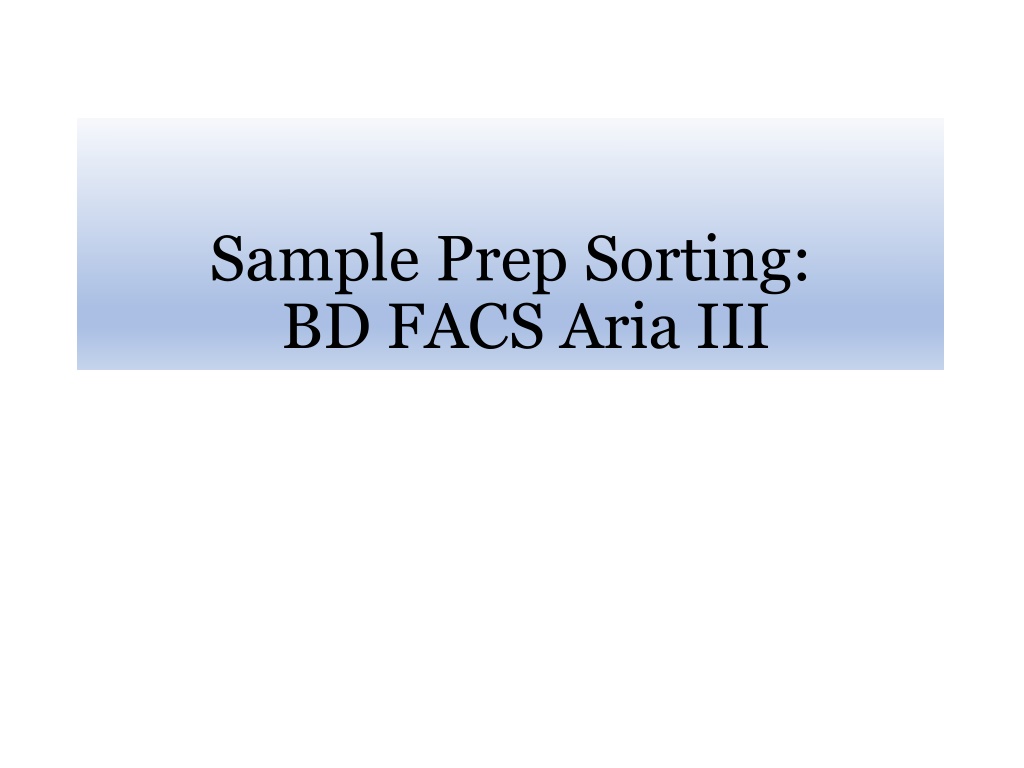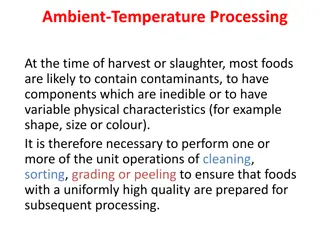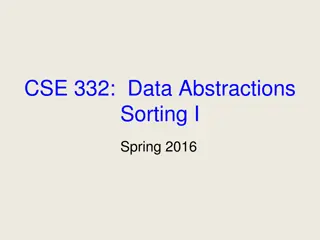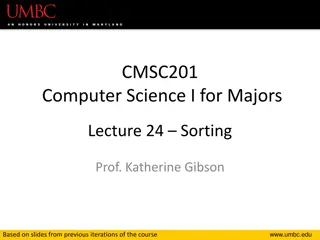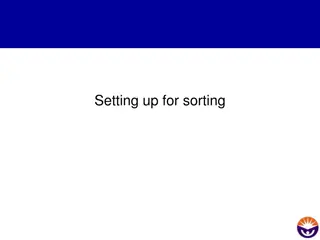Understanding BD FACS Aria III for Efficient Cell Sorting
Learn about the BD FACS Aria III, a sterile cell sorter capable of analyzing up to 15 colors and sorting up to 4 populations simultaneously. Recommended sample concentrations, sorting procedures, and tube preparation guidelines are provided for efficient cell sorting. Discover important tips to ensure optimal sorting efficiency and cell viability. Dive into the details of this advanced instrument to enhance your cell sorting workflows.
Download Presentation

Please find below an Image/Link to download the presentation.
The content on the website is provided AS IS for your information and personal use only. It may not be sold, licensed, or shared on other websites without obtaining consent from the author. Download presentation by click this link. If you encounter any issues during the download, it is possible that the publisher has removed the file from their server.
E N D
Presentation Transcript
Sample Prep Sorting: BD FACS Aria III
BD FACS Aria III Excitation Laser 488 nm (blue) Detection Filter 695/40 (675-715 nm) Example PERCP/5.5, 7AAD, EPRCP- EF710 AF488, GFP, FITC 515/20 (505 525 nm) 561 nm (green) 780/60 (750- 810 nm) PE-CY7 710/50 (685-735 nm) PE-CY5 670/30 (655-685 nm) PE-CY5.5 610/20 (600-630 nm) PE-TXRED, PI, MCHERRY, CF594 PE 582/15 (574-590 nm) 633 nm (red) 780/60 (750-810 nm) APC-Cy7, APC-EF780 720/40 (700-740 nm) AF700 660/20 (650-670 nm) APC, AF647, EF660 407 nm (violet) 710/50 (685-735 nm) BV711 660/20 (650-670 nm) BV650, QD655 610/20 (600-630 nm) BV605, QD605 525/50 (500-550 nm) BV510, AMCYAN 450/50 (425-475 nm) DAPI, BV421, EF450, PACBLUE
BD FACS Aria III The BD FACS Aria III is a sterile cell sorter. It can analyze up to 15 colors and sort up to 4 populations at one time. Samples are run by core personnel. The cell sorter is housed in a Biosafety hood allowing for the sorting of BSL-2 samples, including patient samples. No BSL-3 samples can be sorted. Samples do not need to be fixed to run on this instrument. However, source of the samples should be disclosed to the flow personnel.
FACSAria sorting samples Recommended sample concentration is 10 million cells/ml and adjust according to your cells count with a minimum final volume of 200 ul. For final volume, cells need to be diluted in sorting buffer. Recipe can be found here: https://medicine.uams.edu/mbim/research-cores/flow- cytometry-core-facility/protocols-and-reagents/sorting-and-staining- buffers/ If cells are over diluted, it causes unnecessarily long sort times and too concentrated samples causes poor sorting efficiency. You can bring extra sorting buffer with you so that cells can be diluted, if necessary, by core personnel. Filter cells through blue cap filter tubes (BDFalccon #352235) prior to bringing to the core for sorting. If any clumps are visible, then cells will not be sorted
FACSAria sorting samples Bring collection tubes you want to sort live cells into. We can sort into 96 well plates, 5 ml FACS tubes, 15 ml conical tubes and 1.5 ml microcentrifuge tubes. If sorting more than 2 populations at once, 15 ml tubes cannot be used. Prepare collection tubes with 0.5-1 ml of media or solution of your choice in the collection tubes to preserve viability. It is recommended for low cell number to also coat the insides of the collection tubes to prevent cells sticking to sides and drying out. To coat the tubes, fill them with 4% BSA in 1X PBS (filter-sterilized) and incubate at 4C for at least 1 hour prior to sorting or overnight. Just prior to bringing the tubes for sorting, pour out the BSA and then add about 0.5 ml of media to the tubes. Polypropylene tubes are recommended for collection. The Aria charges the stream to sort cells and a charge may build around polystyrene tubes as the cells are sorted. Initial samples may be in either polystyrene tubes or polypropylene tubes. After sorting, it is recommended the cells rest on ice for 30-60 minutes before moving to next step as the sorting procedure puts the cells under strain and stress. Not resting after the sort can lead to increased cell death.
Preparing Cells All cell types require different digestion, harvesting, and isolation techniques. It is recommended you find a protocol specific for your cell type that gives you a single cell suspension with optimal cell number recovery. COUNT YOUR CELLS! This step is very important. After cell collection and prior to staining, count your cells. This will help you determine antibody concentrations, as well as determine if your cell harvest was successful and you have enough cells to stain. Make sure you have a single cell suspension. If you see clumps in your sample, these cannot be run on the cytometer. They can damage the instrument and cause inaccurate results. All samples should be filtered through a 40 m cell strainer topped 5 ml FACs tube before bringing the samples to the flow core.
Staining Protocol All cell types require different variations to the staining protocol, so it s best to find protocols specific to your assay/cell type. There are many protocols available on-line and on antibody manufacturer websites. A viability dye is always needed for sorting cells. Commons ones to use are PI, DAPI and 7AAD. It is highly recommended that you test your protocols on a small sample size prior to staining a large number of cells/samples on valuable cells. Keep it simple to start. Do not use your two month highly expensive or valuable experimental samples for your first flow run. A generic staining protocol can be found on my website here: https://medicine.uams.edu/mbim/research-cores/flow-cytometry- core-facility/sample-submission/sample-preparation/
Experimental Quality Controls Quality control samples are needed with each experiment. Best practice is to prepare these with each run. A multi-color experiment cannot be run without proper controls. For best practice, the controls needed for each experiment are as follows: Negative/unstained cells Single stain controls for each color FMOs (fluorescence minus one) for each color. If only staining/sorting for a single color, then just a negative unstained control is required If you are using the same panel for multiple days of an experiment then settings can be re-used but additional compensation may be needed within FlowJo These controls are needed to set instrument voltages and compensate the samples, while the FMOs are used in analysis to set the positive and negative gates for each color (fluorophore).
Experimental Quality Controls The single stain/compensation controls are used to set up the instrument and samples cannot be run without them. Example: A panel stained with FITC=CD3, PE=CD4, APC=B220, and EF780=viability dye Tube 1. Cells only Tube 2. Cells stained with FITC CD3 only Tube 3. Cells stained with PE CD4 only Tube4. Cells stained with APC B220 only Tube 5. Cells stained with ef780 viability only
Experimental Quality Controls FMO controls are used for analysis purposes. When drawing gates to determine which proportion of the cell population expresses a given marker, these controls are used to help set the positive and negative gates. While some populations have clear pos/neg expression, low expressing markers or markers that just cause a slight shift are easier to confidently gate on with FMO controls FMO example: Using the same panel listed on previous slide FMO controls would be: Tube 6: FITC FMO- Cells with all stains except FITC Tube 7: PE FMO- Cells with all stains except PE Tube 8: APC FMO- Cells with all stains except APC Tube 9: ef780 viability FMO- Cells with all stains except ef780
Experimental Quality Controls Some cells types are prohibitive in the number of cells available, making it difficult to generate control samples. In these instances other options are available. For example, many researchers will use splenocytes or other abundant tissue types to harvest cells to stain for controls. Beads can also be used. Make sure that the sample/cells chosen for the single stain controls will express your marker. There has to be a positive population for the marker to accurately compensate. If you are unsure that the marker you are using is expressed by the cells in your assay, then chose another marker that is expressed to make this control. For example: Many researchers use CD4 for all the single stain controls to ensure good expression. The marker can differ from the one in your panel as long as it s the same color and expressed by cells in your sample.
Samples Samples must be in 5ml- 12x75mm polystyrene round bottom tubes BD Flacon brand (catalog # 352052) to be ran on Fortessa or Celesta. No other sized tubes will work. The recommended sample concentration is 10 million cells/ml and adjust according to your cell count with a minimum final volume of 200 ul. If cells are over diluted, it causes unnecessary long run times. Filter cells prior to bringing to the core. If aggregates are present, the samples cannot be ran as it will clog the instrument. Include a form with samples indicating all necessary info: Lab name, your name, contact info, staining panel including markers & colors used, cell type, etc. This must be submitted with samples, or it can be emailed to core personnel ahead of time. Make sure tubes are numbered or labeled legibly to prevent mishandling of tubes out of order. For sorting, it is recommended samples are brought on ice
